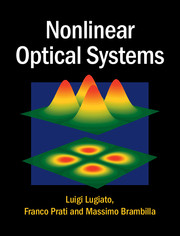Book contents
- Frontmatter
- Dedication
- Contents
- Preface
- Part I Models, propagation, stationary phenomena
- Part II Dynamical Phenomena, Instabilities, Chaos
- Part III Transverse optical patterns
- Appendix A The Routh–Hurwitz stability criterion
- Appendix B Calculation of the oscillatory instability boundary
- Appendix C Coefficients of the characteristic equation (20.20)
- Appendix D Derivation of equations (20.27) and (20.28)
- Appendix E Coefficients of equations (20.60) and (20.61)
- Appendix F The exact boundary of the Risken–Nummedal–Graham–Haken instability
- Appendix G Nonlinear analysis of the roll solution
- References
- Index
Part I - Models, propagation, stationary phenomena
Published online by Cambridge University Press: 05 March 2015
- Frontmatter
- Dedication
- Contents
- Preface
- Part I Models, propagation, stationary phenomena
- Part II Dynamical Phenomena, Instabilities, Chaos
- Part III Transverse optical patterns
- Appendix A The Routh–Hurwitz stability criterion
- Appendix B Calculation of the oscillatory instability boundary
- Appendix C Coefficients of the characteristic equation (20.20)
- Appendix D Derivation of equations (20.27) and (20.28)
- Appendix E Coefficients of equations (20.60) and (20.61)
- Appendix F The exact boundary of the Risken–Nummedal–Graham–Haken instability
- Appendix G Nonlinear analysis of the roll solution
- References
- Index
Summary
Three elements, introduced in Part I of the book, play a key role in the book itself.
The first is the derivation of the Maxwell–Bloch equations, which is carried out in Chapters 2–4. In particular the derivation of the field-envelope equation, discussed in Section 3.1, is explained with special care. The derivation is based, of course, on the slowly varying envelope approximation and on the paraxial approximation. In textbooks these two approximations are usually discussed separately and rather briefly. We show that the two approximations are intimately connected, and only in this way it is possible to demonstrate that, while the second-order derivatives with respect to time and to the longitudinal coordinate z can be neglected, the second-order derivatives with respect to the transverse coordinates x and y must be kept. It is also possible to demonstrate that the term ∇(∇ · E) in the Maxwell wave equation for the electric field can indeed be neglected. An additional bonus of this approach is that, once one has shown in detail the derivation of the envelope equation in the simplest context, it becomes straightforward to generalize it to the more complex cases of frequency dispersion in the background refractive index (Section 5.4) and of quadratic and cubic nonlinearities (Chapters 6 and 7).
The second key element is the use of a multiple limit in the parameters, which in the literature is called the mean-field limit or uniform-field limit, whereas in this book we prefer to name it more precisely the low-transmission limit. This plays a central role when we derive modal equations and single-mode models from sets of equations with propagation. In this way one avoids, for example, steps like the phenomenological introduction of a damping term in the field equation(s) to describe the escape of photons from the cavity, and derives the damping from the boundary conditions of the cavity in a transparent way (Chapters 12 and 14).
- Type
- Chapter
- Information
- Nonlinear Optical Systems , pp. 1 - 4Publisher: Cambridge University PressPrint publication year: 2015



